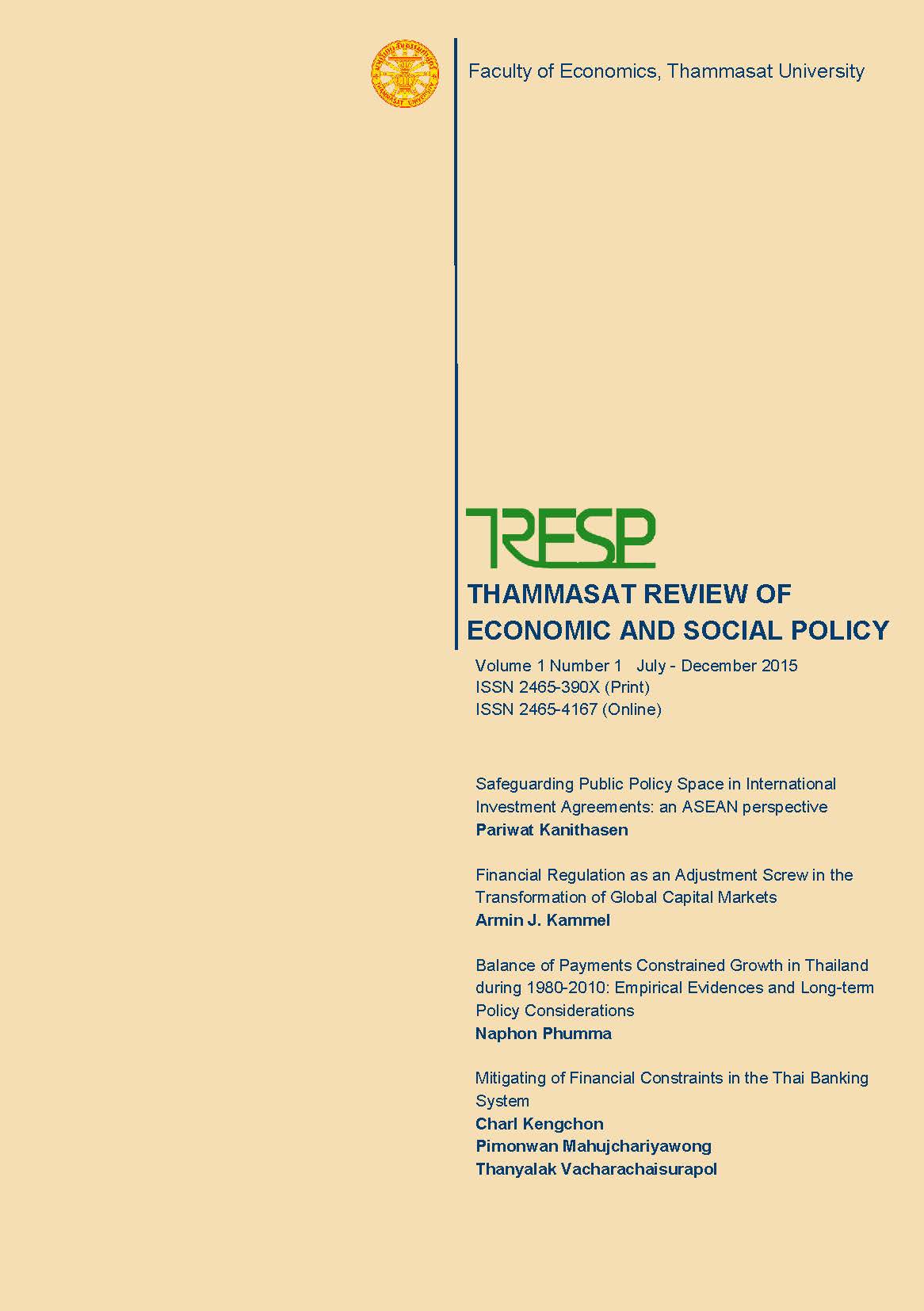Mitigating of Financing Constraints in the Thai Banking System
DOI:
https://doi.org/10.14456/tresp.2015.4Abstract
The objective of this article is to analyze the development in mitigation of “financing constraints” in Thai banking system for both corporate and household sectors since the Asian Financial Crisis in 1997, which was a great turning point for the economic and banking system. The issue concerning financing constraints for business firms and households is considered as one of the most significant financial problems, causing the economy to be in a suboptimal equilibrium. This study found that the issues pertaining to financing constraints for business firms and household have been eased owing to several reasons. Banking innovations have been boosted due to changing competition landscape, and transformation of business goals under the restructuring of Thai laws and new economic conditions. Emergence of such innovations reflects right puzzles between risk management, operational procedures and IT, marketing and communications, as well as sales and service channels putting together, thereby assisting small and medium-sized enterprises (SMEs) and the household sector to gain better access to financing, either in dimension of quality, quantity and pricing. This is in line with the empirical evidence indicating that the changing cost of borrowing for entrepreneurs during the recent period was partly due to the development of financial system, competition among Thai banks and development of business banking innovations. All these factors assisted small firms which have enhanced their potential to access financial capital, closing the gap between them and bigger firms. Nevertheless, the different economic and financial conditions leave the issue open-ended for all the concerned institutions in determining the “appropriate” policy design to encourage the corporate and household sectors to access credits from banks under appropriate terms and conditions without affecting the long-term economic stability for the future challenges.
References
Ayyagari, M., Demirguc-Kunt A. & Maksimovic V. (2006). How Important Are Financing Constraints?: The Role of Finance in the Business Environment. World Bank Publications.
Bank of Thailand (2011). Survey Report on Financial Accessibility of Thai Household Sector in 2010. (In Thai)
Bank of Thailand (2014). Survey Report on Financial Accessibility of Thai Household Sector in 2013. (In Thai)
Beck, T., Demirguc-Kunt, A. & Maksimovic, V. (2005). Financial and Legal Constraints to Growth: Does Firm Size Matter?. The Journal of Finance. 60.1: 137-177.
Beck, T., Demirgüç-Kunt, A., Laeven, L., & Maksimovic, V. (2006). The determinants of financing obstacles. Journal of International Money and Finance, 25(6), 932-952.
Beck, T., Demirguc-Kunt, A. & Peria, M. S. M. (2008). Bank Financing for SMEs Around the World: Drivers, Obstacles, Business Models, and Lending Practices. World Bank Policy Research Working Paper.
Berger, A. N. & Udell, G. F. (1995). Relationship Lending and Lines of Credit in Small Firm Finance. Journal of Business. 351-381.
Berger, A. N., Frame, W. S. & Miller, N. H. (2005). Credit Scoring and The Availability, Price, and Risk of Small Business Credit. Journal of Money, Credit and Banking. 37.2: 191-222.
Blundell, R., Griffith, R. & Reenen, J. V. (1995). Dynamic Count Data Models of Technological innovation. The Economic Journal. 333-344.
Clarke, G., Cull, R., Peria M. & Sanchez S. M. (2001). Foreign Bank Entry: Experience, Implications for Developing Countries, and Agenda for Further Research. World Bank Policy Research Working Paper.
Cleary, S. (1999). The Relationship Between Firm investment and Financial Status. The Journal of Finance. 54.2: 673-692.
Cleary, S. (2006). International Corporate Investment and The Relationships Between Financial Constraint Measures. Journal of Banking & Finance. 30.5: 1559- 1580.
Cole, R. A., Goldberg, L. G. & White, L. J. (2004). Cookie Cutter vs. Character: The Micro Structure of Small Business Lending by Large and Small Banks. Journal of Financial and Quantitative Analysis. 39.02: 227-251.
Demirguc-Kunt A. & Maksimovic, V. (1998). Law, Finance, and Firm Growth. The Journal of Finance. 53.6: 2107- 2137.
Fazzari, S. M., Hubbard, R. G. & Petersen, B. C. (1988). Financing Constraints and Corporate Investment. National Bureau of Economic Research.
Frame, W. S., Srinivasan, A. & Woosley, L. (2001). The Effect of Credit Scoring on Small-Business Lending. Journal of Money, Credit and Banking. 813- 825.
Gelos, R. G. & Werner, A. M. (2002). Financial Liberalization, Credit Constraints, and Collateral: Investment in the Mexican Manufacturing Sector. Journal of Development Economics. 67.1: 1-27.
Haas, R. D. & Naaborg, I. (2005). Foreign Banks in Transition Economies: Small Business Lending and Internal Capital Markets. International Finance.
Howitt, P. (2007). Innovation, Competition and Growth. CD Howe institute.
Hubbard, R. G. (1998). Capital-Market Imperfections and investment. National Bureau of Economic Research.
Kaplan, S. N. & Zingales, L. (1997). Do Investment-Cash Flow Sensitivities Provide Useful Measures of Finance Constraints?. Quarterly Journal of Economics. 112: 169-215.
Kaplan, S. N. & Zingales, L. (2000). investment-Cash Flow Sensitivities Are Not Valid Measures of Financing Constraints. Quarterly Journal of Economics. 115: 707- 712.
Kaufmann, D., Batra, G. & Stone, A. H. W. (2003). The Firms Speak: What The World Business Environment Survey Tells Us about Constraints on Private Sector Development. World Bank Mimeo.
Levine, R. (2005). Finance and Growth: Theory and Evidence. Handbook of Economic Growth. 1: 865-934.
Musso, P. & Schiavo, S. (2008). The Impact of Financial Constraints on Firm Survival and Growth. Journal of Evolutionary Economics. 18.2: 135-149.
Paulson, A. L. & Townsend, R. (2004). Entrepreneurship and Financial Constraints in Thailand. Journal of Corporate Finance. 10.2: 229-262.
Paulson, A. L. & Townsend, R. (2005). Financial Constraints and Entrepreneurship: Evidence from the Thai Financial Crisis. Economic Perspectives. 29.3: 34-48.
Porter, M. E. (1990). The Competitive Advantage of Nations. Harvard Business Review.
Rajan, R. G. & Zingales, L. (1998). Financial Dependence and Growth. American Economic Review. 559-586.
Stiglitz, J. & Weiss, A. (1981). Credit Rationing in Markets with Imperfect information. American Economic Review. 71(3), June, 393-410
Theerawongseri, V. (2003). Financial Constraints on invesment of Thai Firms. Master Thesis. Thammasat University.



